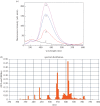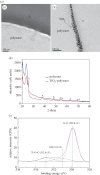Effect of surface pretreatment of TiO2 films on interfacial processes leading to bacterial inactivation in the dark and under light irradiation
- PMID: 25657831
- PMCID: PMC4275866
- DOI: 10.1098/rsfs.2014.0046
Effect of surface pretreatment of TiO2 films on interfacial processes leading to bacterial inactivation in the dark and under light irradiation
Abstract
Evidence is presented for radio-frequency plasma pretreatment enhancing the amount and adhesion of TiO2 sputtered on polyester (PES) and on polyethylene (PE) films. Pretreatment is necessary to attain a suitable TiO2 loading leading to an acceptable Escherichia coli reduction kinetics in the dark or under light irradiation for PES-TiO2 and PE-TiO2 samples. The amount of TiO2 on the films was monitored by diffuse reflectance spectroscopy and X-ray fluorescence. X-ray electron spectroscopy shows the lack of accumulation of bacterial residues such as C, N and S during bacterial inactivation since they seem to be rapidly destroyed by TiO2 photocatalysis. Evidence was found for Ti(4+)/Ti(3+) redox catalysis occurring on PES-TiO2 and PE-TiO2 during the bacterial inactivation process. On PE-TiO2 surfaces, Fourier transform infrared spectroscopy (ATR-FTIR) provides evidence for a systematic shift of the na(CH2) stretching vibrations preceding bacterial inactivation within 60 min. The discontinuous IR-peak shifts reflect the increase in the C-H inter-bond distance leading to bond scission. The mechanism leading to E. coli loss of viability on PES-TiO2 was investigated in the dark up to complete bacterial inactivation by monitoring the damage in the bacterial outer cell by transmission electron microscopy. After 30 min, the critical step during the E. coli inactivation commences for dark disinfection on 0.1-5% wt PES-TiO2 samples. The interactions between the TiO2 aggregates and the outer lipopolysaccharide cell wall involve electrostatic effects competing with the van der Waals forces.
Keywords: TiO2 interface; aggregation; bacterial inactivation; dark disinfection; thin film; transmission electron microscopy.
Figures












Similar articles
-
New evidence for TiO2 uniform surfaces leading to complete bacterial reduction in the dark: critical issues.Colloids Surf B Biointerfaces. 2014 Nov 1;123:593-9. doi: 10.1016/j.colsurfb.2014.09.060. Epub 2014 Oct 7. Colloids Surf B Biointerfaces. 2014. PMID: 25444660
-
New evidence for Cu-decorated binary-oxides mediating bacterial inactivation/mineralization in aerobic media.Colloids Surf B Biointerfaces. 2016 Aug 1;144:222-228. doi: 10.1016/j.colsurfb.2016.03.072. Epub 2016 Apr 6. Colloids Surf B Biointerfaces. 2016. PMID: 27088192
-
Quasi-Instantaneous Bacterial Inactivation on Cu-Ag Nanoparticulate 3D Catheters in the Dark and Under Light: Mechanism and Dynamics.ACS Appl Mater Interfaces. 2016 Jan 13;8(1):47-55. doi: 10.1021/acsami.5b09730. Epub 2015 Dec 23. ACS Appl Mater Interfaces. 2016. PMID: 26699928
-
Preparation and Mechanism of Cu-Decorated TiO2-ZrO2 Films Showing Accelerated Bacterial Inactivation.ACS Appl Mater Interfaces. 2015 Jun 17;7(23):12832-9. doi: 10.1021/acsami.5b02168. Epub 2015 Jun 5. ACS Appl Mater Interfaces. 2015. PMID: 26023896
-
Self-Sterilizing Sputtered Films for Applications in Hospital Facilities.Molecules. 2017 Jun 28;22(7):1074. doi: 10.3390/molecules22071074. Molecules. 2017. PMID: 28657579 Free PMC article. Review.
Cited by
-
Green synthesis of carbon quantum dots embedded onto titanium dioxide nanowires for enhancing photocurrent.R Soc Open Sci. 2017 May 10;4(5):161051. doi: 10.1098/rsos.161051. eCollection 2017 May. R Soc Open Sci. 2017. PMID: 28572996 Free PMC article.
-
Mesoporous TiO2 Monoliths Impregnated with CdS and CuO Nanoparticles for Airborne Bacteria Inactivation Under Visible Light.Catal Letters. 2022;152(3):629-640. doi: 10.1007/s10562-021-03659-9. Epub 2021 May 23. Catal Letters. 2022. PMID: 34054251 Free PMC article.
-
Novel integrated approach of adsorption and photo-oxidation using Ag-TiO2/PU for bioaerosol removal under visible light.Chem Eng J. 2015 Sep 1;275:357-365. doi: 10.1016/j.cej.2015.04.055. Epub 2015 Apr 16. Chem Eng J. 2015. PMID: 32372878 Free PMC article.
References
-
- Fujishima A, Zhang X, Tryk D. 2008. TiO2 photocatalysis and related phenomena. Surf. Sci. Rep. 63, 515–582. (10.1016/j.surfrep.2008.10.001) - DOI
-
- Page K, Wilson M, Parkin PI. 2009. Antimicrobial surfaces and their potential in reducing the incidence of hospital acquired infections. J. Mater. Chem. 19, 3819–3831. (10.1039/b818698g) - DOI
-
- Daoud W. (ed.). 2013. Self-cleaning materials and surfaces. Cambridge, UK: Woodhead Publishing Co.
-
- Mills A, Lee S. 2002. A web-based overview of semiconductor photochemistry-based current commercial applications. J. Photochem. Photobiol. A 152, 233–247. (10.1016/S1010-6030(02)00243-5) - DOI
Publication types
LinkOut - more resources
Full Text Sources
Other Literature Sources
Miscellaneous

